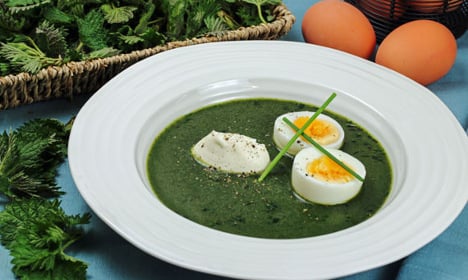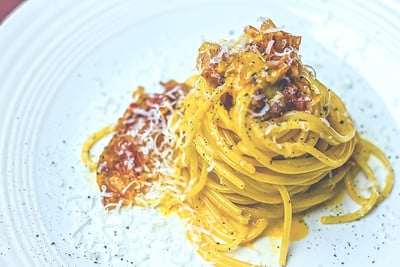As the weather gets warmer this time of the year, Swedes flock to the forest to pick nettles for this delicious and traditional dish. Because you can source the main ingredient yourself, it won't put a strain on your wallet – just mind that you don't get stung.
Summary
Serves: 4
Preparation: 10 minutes
Cooking: 10 minutes
Total: 20 minutes
Ingredients
2 litres (8 cups) stinging nettle shoots
1.05 litres (4 1/2 cups) water
1 tsp salt
45g butter (3 tbsp) butter
25g (1/2 cup) chopped chives
1-2 chicken bouillon cubes
1-2 vegetable bouillon cubes
1 tsp dried thyme
pinch of white pepper
1-2 tsp cornflour (cornstarch)
4 hard boiled eggs
120ml (1/2 cup) crème fraîche
Method
1. Rinse the nettles well by swishing them around in a sink of cold water and letting them float for a couple of minutes so any dirt will sink to the bottom. They will still sting at this stage so work carefully. Gently remove the nettles from the water trying not to disturb dirt in the bottom and keep an eye out for unwanted bugs that need to be removed.
2. Place the nettles in a two-litre stock pot. Add 250ml (1 cup) water and sprinkle a teaspoon of salt over the top of the nettles. Cover and bring to a boil. Reduce heat to a low boil and let the nettles cook for five minutes.
3. If you are comfortable with the cleanliness of your nettles, strain off the cooking water and save it, pressing gently on the nettles to release more of their liquid. Otherwise discard the cooking water.
4. Place the cooked nettles on a cutting board. Strain off the cooking water and save it, pressing gently on the nettles to release more of their liquid. Place the cooked nettles on a cutting board and chop finely.
5. Melt the butter in the same stock pot over medium heat. Add the chives and cook for one to two minutes. Crumble the bouillon cubes into the mix, breaking them up and stirring to dissolve them into the butter.
6. Add the chopped nettles to the stock pot along with the saved cooking liquid, a further 800ml (3 1/2 cups) of water, thyme and a pinch of white pepper. If you weren't able to save the cooking liquid, add a further 250ml (1 cup) of water.
7. Dissolve the corn flour in a little water and stir it into the soup.
8. Serve hot with halved hard boiled eggs for garnish, some crème fraîche and bread.
Tips
– Only use nettles less than 30cm (1ft) high because otherwise they will be fibrous and tough.
– Avoid nettles that are flowering: they are too old.
– For the best flavour, pick only the top four or six leaves on each spear.
– The soup freezes well, but you can also freeze the nettle tops.
This recipe was written by Maia Brindley Nilsson and published on food writer John Duxbury's Swedish Food website.




 Please whitelist us to continue reading.
Please whitelist us to continue reading.